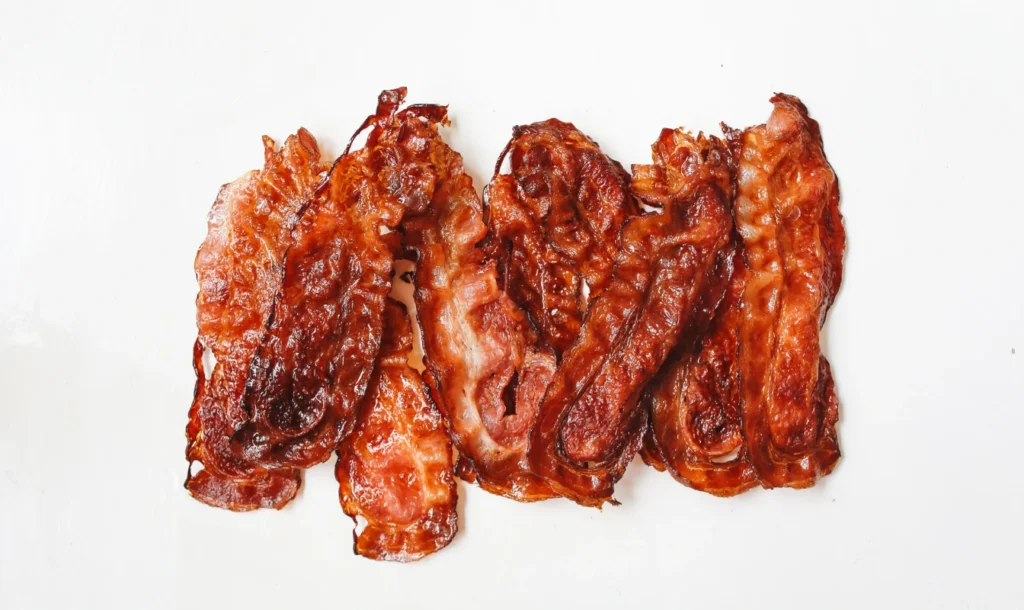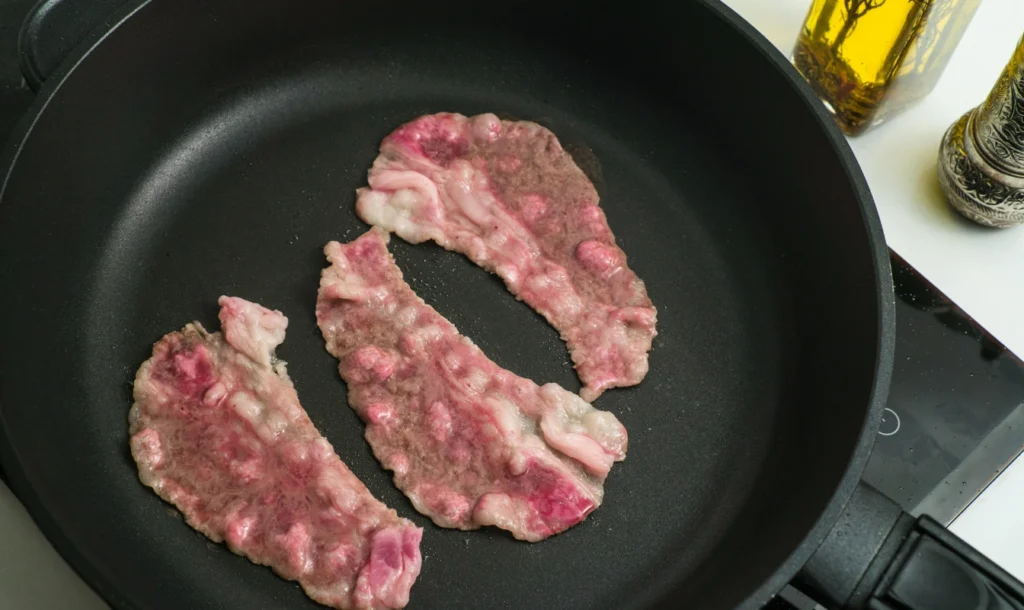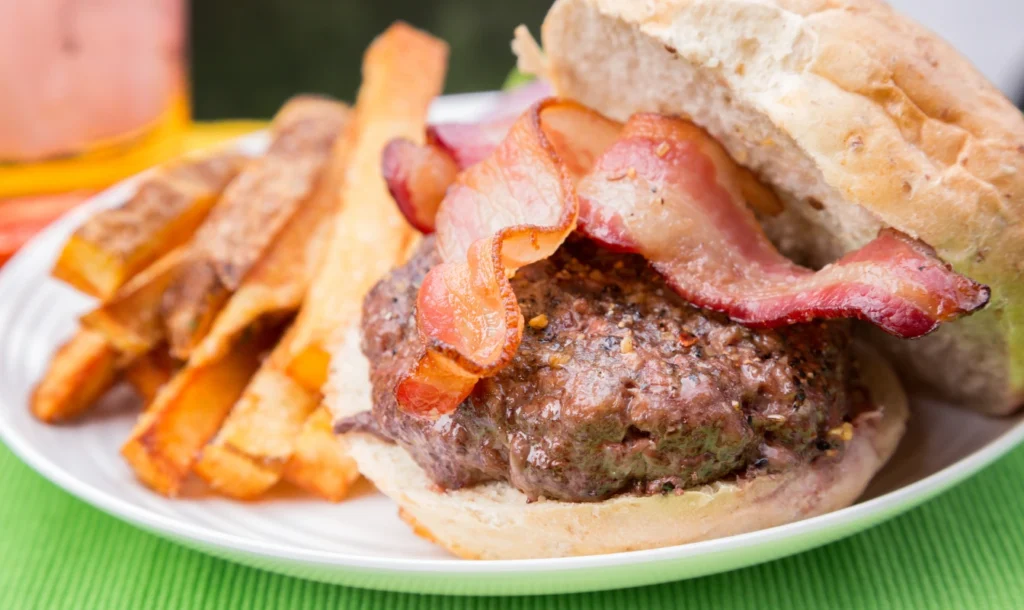What is Beef Bacon?
Beef bacon, unlike its pork counterpart, is made from the belly or brisket of beef, offering a unique flavor profile and catering to those who prefer or require alternatives to pork. This delectably rich delicacy combines the savory taste of traditional bacon with the robust characteristics of beef, creating a mouth-watering experience for meat lovers. What sets beef bacon apart is its preparation method, often involving a curing process similar to that of pork bacon, which enhances its flavor and preserves the meat. The result is a crispy, smoky product that can be enjoyed in various dishes, from breakfast platters to gourmet burgers.
Benefits of Homemade Beef Bacon
Making beef bacon at home has its own set of rewards. Beyond the pride of crafting something unique, there are several compelling benefits:
- Customization: When you create your beef bacon, you can control the flavors. Whether you prefer a sweet maple glaze or a spicy chipotle kick, the choice is yours.
- Quality Control: Homemade bacon allows you to select high-quality beef without additives or preservatives that are often found in store-bought options.
- Cost-Effectiveness: Though initially time-consuming, making beef bacon can be more economical than frequently purchasing pre-packaged bacon, especially if you buy in bulk.
- Healthier Option: By preparing your beef bacon, you can regulate the fat content and choose hormone-free, grass-fed beef, offering a more nutritious alternative.
Incorporating these benefits leads to a rewarding culinary experience, whether enjoyed solo or shared with loved ones, reinforcing the idea that cooking at home is both satisfying and delicious. Now, let’s explore how to select the right cut of beef for your homemade bacon adventure.
Choosing the Right Cut of Beef
Best Cuts for Beef Bacon
When it comes to creating mouth-watering beef bacon, choosing the right cut is essential for achieving that perfect balance of flavor and texture. Here are the best cuts to consider:
- Brisket: Known for its rich flavor and marbling, brisket is a favorite for creating beef bacon. The fat content helps render down during cooking, giving you that delightful crispy texture.
- Beef Belly: Similar to pork belly, beef belly is indulgently fatty and creates a luscious bacon product. It’s a bit less common but can yield outstanding results.
- Flank Steak: While it’s leaner than other cuts, flank steak can still produce tasty beef bacon, particularly when marinated or seasoned well.
- Chuck Roast: This cut is flavorful and has a good amount of fat, making it suitable for beef bacon as well. It’s often more affordable, making it an excellent choice for budget-conscious cooks.
Choosing the right cut ensures that your homemade beef bacon is not only delicious but also enjoyable to prepare.
Factors to Consider When Selecting Beef
When selecting beef for bacon, keep several factors in mind to ensure the best outcome:
- Fat Content: Look for cuts with a higher fat-to-meat ratio for a more succulent bacon. Ideally, aim for about 30% fat content.
- Quality: Opt for grass-fed or organic beef whenever possible. This not only improves the flavor but also provides a healthier option with fewer chemicals and additives.
- Freshness: Fresh beef will always produce better results. Check the sell-by date and ensure there is no discoloration or unpleasant odors.
- Budget: While quality is important, it’s also essential to consider your budget. Cuts like chuck roast and brisket offer a nice balance of quality and price.
Making informed decisions about the cuts and qualities of beef will create a robust starting point for your beef bacon journey. Now, let’s delve into the essential aspects of brining and flavoring your bacon to take it to the next level.

Brining and Flavoring
Importance of Brining
Brining is a critical step in the process of making delicious beef bacon. It not only helps to enhance the flavor but also plays a key role in preserving the meat. Think of brining as a flavor bath that infuses the beef with moisture and taste, preventing it from drying out during cooking. Here are some reasons why brining should not be overlooked:
- Flavor Enhancement: Brining allows the meat to absorb various flavors from spices and herbs, imparting a depth that enhances the overall taste of the bacon.
- Moisture Retention: The process helps the meat retain moisture, resulting in a juicier finished product. This is particularly beneficial when cooking, as it prevents dryness.
- Preservation: Brining acts as a preservative, slowing down the growth of bacteria, which is especially important when making bacon at home.
With these benefits in mind, it’s clear that brining is a vital step to achieving the best homemade beef bacon possible.
Flavoring Options and Techniques
Now that you’ve decided to brine your beef bacon, it’s time to explore various flavoring options and techniques to spice things up. Here are some exciting ideas:
- Sweet Brines: Combine ingredients like brown sugar and maple syrup with traditional salt to create a sweet and savory flavor profile.
- Smoky Flavor: Add liquid smoke or smoked paprika to your brine for a robust smoky taste that complements the beef beautifully.
- Herbs and Spices: Incorporate fresh or dried herbs such as thyme, rosemary, or cracked black pepper into your brine for a fragrant kick.
- Citrus Elements: Zest from lemons or oranges can add a refreshing brightness to your brine.
- Infusion Techniques: To really up the game, consider using spices like crushed red pepper flakes or garlic powder. Allow the brine to sit for a bit to let the flavors meld before immersing your beef.
Experimenting with different brines and flavoring techniques can result in an extraordinary batch of beef bacon tailored to your taste preferences. With your beef well-brined and flavored, the next step is the curing process that solidifies these delightful, savory notes.
Curing Process
Curing Methods for Beef Bacon
Once your beef has been beautifully brined and flavored, the next crucial step is the curing process. Curing not only enhances the flavor but also gives bacon its signature texture and preserves it for longer. Here are the most commonly used curing methods:
- Dry Curing: This traditional method involves rubbing a mixture of salt, sugar, and spices directly onto the beef. Simply coat every side evenly and then wrap the meat tightly in plastic wrap. This method can take longer, but it allows for deeper flavor penetration.
- Wet Curing: Also known as brining, this method immerses the beef in a saltwater solution infused with sugar and spices. This quicker option can help infuse moisture and flavor more rapidly, making it easier for beginners.
- Cold Curing: This method involves curing the beef in a temperature-controlled environment, typically below 40°F (4°C). It’s essential to monitor the temperature carefully to prevent spoilage and ensure proper curing.
Each method has its own advantages, and choosing one can depend on the time you have available and the flavors you wish to achieve.
Duration and Temperature Guidelines
Understanding the duration and temperature of the curing process is vital for success. Here are some guidelines to keep in mind:
- Dry Curing Duration: For dry curing, the recommended time is about 5 to 7 days per inch of thickness. Make sure to turn the meat every couple of days to ensure an even cure.
- Wet Curing Duration: If you’re taking the wet curing route, aim for 48 hours to 7 days in the brine, depending on the thickness of your cut. The beef should be flipped halfway through to ensure even coverage.
- Temperature Control: Maintain a consistent temperature of around 36°F (2°C) for wet curing. For dry curing, the same temperature will work but ensure it’s in a cool, ventilated space.
Monitoring these factors guarantees that your beef bacon will not only be safe to eat but also deliciously flavored. Now, as we advance, let’s dive into the exciting world of smoking your beef bacon to infuse it with that perfect smoky goodness.
Smoking Beef Bacon
Types of Wood for Smoking
Once your beef bacon has been cured, it’s time for the next step: smoking. Smoking imparts that unmistakable flavor that elevates the beef bacon experience. The type of wood you choose can significantly influence the taste, so here’s a rundown of popular wood types for smoking:
- Hickory: Known for its strong, smoky flavor, hickory is a favorite among bacon enthusiasts. It pairs well with beef, adding depth to the meat.
- Applewood: Offering a milder, slightly sweet taste, applewood provides a more delicate profile. If you’re looking for a fruity flavor, this is a fantastic choice.
- Cherrywood: Similar to applewood, cherrywood also brings a subtle sweetness while giving the beef a beautiful reddish color. It’s an excellent option for those wanting visually appealing bacon.
- Mesquite: If you enjoy a bold and strong smoke flavor, mesquite should be on your radar. Use it sparingly, as it can easily overpower the meat.
Experimenting with different woods can be a fun way to discover your favorite flavor combinations. Keep in mind that you can also blend different wood types for a unique smoking experience!
Smoking Equipment and Tips
Now that you’ve chosen the wood, it’s time to gather your smoking equipment. Here are some essential tools you’ll need:
- Smoker: Whether you have a traditional charcoal smoker, an electric smoker, or a wood pellet grill, ensure it’s set up for low and slow cooking.
- Thermometer: A reliable thermometer is crucial to monitor the internal temperature of your beef bacon throughout the smoking process. Aim for an internal temperature of 150°F (65°C) for safe consumption.
- Smoke Box or Pellet Tray: If you’re using a grill instead of a dedicated smoker, a smoke box or pellet tray helps produce smoke without imparting too much heat.
- Water Pan: Placing a pan of water in your smoker helps maintain moisture in the cooking environment, leading to juicier bacon.
Before you start smoking, remember to preheat your smoker to around 200°F (93°C), ensuring it’s ready for that rich flavor infusion. With these tools and tips at hand, your beef bacon will soon be transformed into a savory delight. Once your smoking session comes to an end, it’ll be time to focus on slicing and cooking the finishing touches!
Slicing and Cooking
Proper Slicing Techniques
After all the hard work of brining, curing, and smoking, you’re almost at the finish line! The next step is slicing your homemade beef bacon to ensure it’s ready for cooking and serving. Proper slicing techniques can greatly affect both the appearance and texture of your bacon. Here are some tips to achieve the best results:
- Use a Sharp Knife: A sharp chef’s knife or a dedicated meat slicer will make clean cuts, preventing the fat from tearing and ensuring even slices.
- Chill Before Slicing: For easier handling, place your smoked beef bacon in the freezer for about 30 minutes before slicing. This will firm it up, allowing for cleaner and more uniform slices.
- Slice Against the Grain: Always slice against the grain of the meat. This technique helps break down the muscle fibers, which results in a more tender bite.
- Thickness Matters: Aim for slices that are about 1/8 to 1/4 inch thick. Thinner slices will crisp up nicely, while thicker pieces retain more chewiness.
Slicing is all about personal preference, so feel free to experiment with thickness until you find what you love!

Cooking Methods
Now that your beef bacon is sliced to perfection, it’s time to explore the various cooking methods at your disposal. Here are a few popular techniques to consider:
- Pan-Frying: This classic method allows you to achieve crispy edges and render out some of the fat. Simply heat a skillet over medium heat and fry the slices for about 5 to 7 minutes, flipping halfway through.
- Baking: For an easier, hands-off approach, baking is a great option. Preheat your oven to 400°F (200°C), line a baking sheet with parchment paper, and arrange the bacon slices in a single layer. Bake for 15-20 minutes, checking periodically for your desired crispness.
- Grilling: If you’re looking for that authentic smoky flavor, grilling is a fantastic choice. Preheat your grill and cook the slices directly over medium heat for a few minutes on each side.
- Air Frying: This method is growing in popularity due to its ability to achieve crispy bacon without excess oil. Preheat the air fryer to around 375°F (190°C) and cook slices for about 10 minutes, flipping once.
Whichever method you choose, be prepared for the mouthwatering aroma that fills your kitchen. Enjoying your delicious homemade beef bacon is the final reward for all your hard work. Now, let’s explore creative ways to serve this amazing culinary treat!
Serving and Storing
Creative Ways to Serve Beef Bacon
Once your homemade beef bacon is perfectly cooked, it’s time to enjoy the fruits of your labor! Beef bacon is versatile and can be utilized in various dishes for a flavorful twist. Here are some creative ways to serve it:
- Breakfast Sandwiches: Layer crispy beef bacon on a toasted bagel or English muffin with eggs and cheese for a hearty breakfast that will kick-start your day.
- Salads: Crumble beef bacon over a fresh salad for added crunch and flavor. It pairs wonderfully with a spinach salad, walnuts, and a tangy vinaigrette.
- Bacon-Wrapped Vegetables: For a crowd-pleasing appetizer, wrap asparagus or jalapeño poppers in beef bacon and bake them until crispy. The combination of textures is undeniably satisfying.
- Pasta Dishes: Add diced beef bacon to pasta sauces for an extra layer of richness. It can elevate creamy sauces or blend beautifully in a classic carbonara.
- Gourmet Burgers: Top your burgers with beef bacon for a savory finish. It adds a luxurious touch to any beef or turkey burger.
These serving ideas not only elevate meals but also showcase the unique flavors of beef bacon, making every bite delightful.

Storage Tips for Homemade Beef Bacon
Properly storing your homemade beef bacon ensures all your hard work doesn’t go to waste. Here are some practical storage tips:
- Refrigeration: If you plan to consume your beef bacon within a week, store it in an airtight container or wrap it tightly in plastic wrap. This protects it from moisture and odors in the fridge.
- Freezing: For longer storage, beef bacon can be frozen. Slice the bacon first, then lay the slices in a single layer on a baking sheet. Once frozen, transfer them to a freezer-safe bag and label with the date. This way, you can easily take out only what you need.
- Thawing: When ready to use frozen beef bacon, thaw it in the refrigerator overnight rather than at room temperature. This keeps the meat safe and preserves its quality.
- Storage Duration: Homemade beef bacon can last up to a week in the refrigerator and around 3 months in the freezer without sacrificing flavor or texture.
Implementing these storage methods will ensure that your delicious homemade beef bacon is always ready when you are, making it a cherished staple in your kitchen. With your beef bacon served and stored, you can share this delightful culinary journey with family and friends. Enjoy every savory bite.
FAQs
1. Can I use any cut of beef for beef bacon?
While brisket, beef belly, flank steak, and chuck roast are ideal, you can experiment with other cuts. Just ensure a good fat-to-meat ratio for optimal flavor and texture.
2. How long does it take to make beef bacon?
The process can take 3-7 days, including brining, curing, and smoking, depending on the curing method and thickness of the beef.
3. Do I need a smoker to make beef bacon?
No, you can use a regular grill with a smoke box or bake it in the oven for a less smoky flavor.
4. Can I make beef bacon without curing salt?
Yes, but curing salt helps with preservation and gives bacon its signature texture and color. If skipping it, consume your bacon quickly and store it properly.
5. What are the best cooking methods for beef bacon?
Pan-frying, baking, grilling, and air frying are all excellent options. Choose based on your desired crispiness and convenience.
Conclusion
Making homemade beef bacon is a rewarding culinary journey that combines creativity, flavor, and satisfaction. From selecting the perfect cut of beef to brining, curing, smoking, and cooking, each step allows you to customize this savory treat to your taste. Its versatility makes it a fantastic addition to various dishes, while proper storage ensures you can enjoy it anytime. With these techniques and tips, you’re well-equipped to craft a flavorful, crispy treat that’s utterly satisfying. So, roll up your sleeves, gather your ingredients, and savor the delight of this labor of love—it’s worth every bite.

